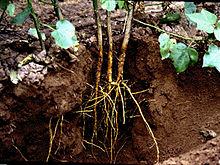**Root Function and Anatomy**:
– Roots absorb water and provide plant nutrition.
– Roots anchor the plant body to the ground and have a cap that helps penetrate soil.
– Root hairs absorb water and nutrients.
– Root morphology has four zones, and they have an endogenous origin.
– Roots synthesize cytokinin in response to nutrients and form symbiotic relationships with fungi.
**Root Growth and Regulation**:
– Apical meristem cells continuously divide.
– Primary growth involves elongation, while secondary growth increases root diameter.
– Vascular cambium forms secondary xylem and phloem, and cork cambium forms protective cork cells.
– Roots sense the physical environment to grow and respond to light, physical barriers, and gravity through auxin pathways.
– Root growth is regulated by genetic and environmental factors, including gravitropism and shade avoidance responses.
**Root System Architecture**:
– Root system architecture refers to the spatial configuration of roots.
– Root architecture provides nutrients, water, and support, adapting to changing environments.
– Classification terms include branch magnitude and topology, and it is regulated by genetic and environmental factors.
– RSA is essential for plant health and growth, influencing nutrient uptake and plant stability.
**Root Types and Adaptations**:
– Types of root systems include true roots, diffuse roots, and adventitious roots.
– Adventitious roots arise from various plant parts and serve functions like gas exchange and storage.
– Roots have adaptations like oxygen absorption in submerged plants and flood tolerance in deepwater rice.
– Canopy roots show convergent evolution in rainforest nutrient cycles, enhancing plant survival in diverse environments.
**Root Interactions and Environmental Impacts**:
– Roots interact with the environment, other plants, and soil microbiota.
– Light impacts root systems, affecting root initiation and elongation.
– Plant-plant interactions occur through root systems, transmitting signals through roots and soil.
– Soil properties and temperature influence root growth and nutrient uptake.
– Roots play a crucial role in nutrient absorption, economic importance, and environmental protection.
In vascular plants, the roots are the organs of a plant that are modified to provide anchorage for the plant and take in water and nutrients into the plant body, which allows plants to grow taller and faster. They are most often below the surface of the soil, but roots can also be aerial or aerating, that is, growing up above the ground or especially above water.

